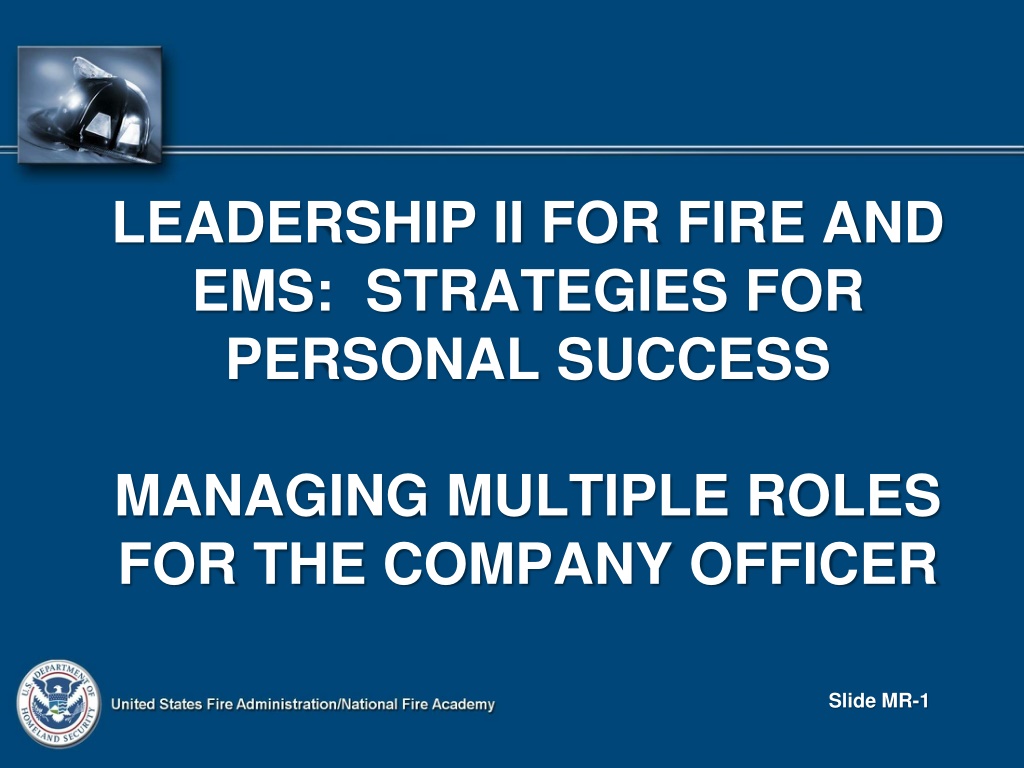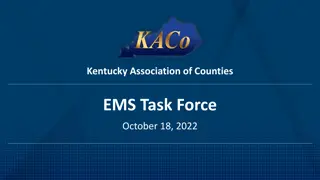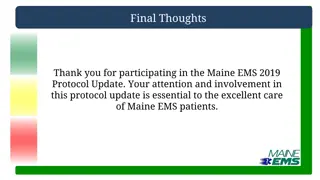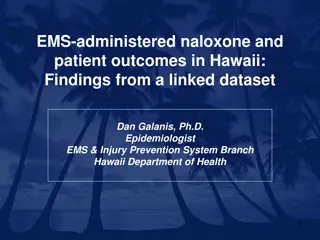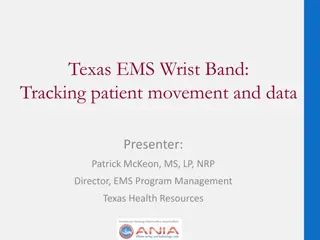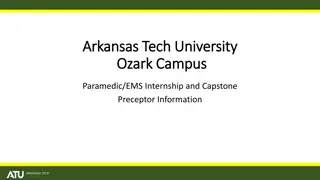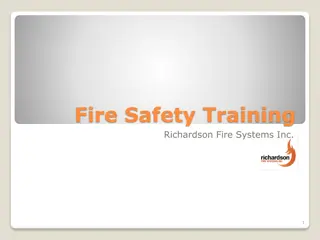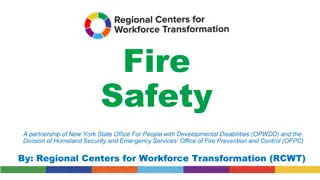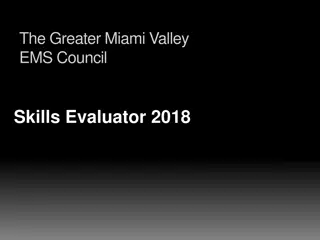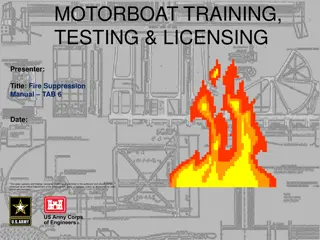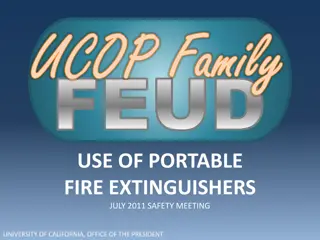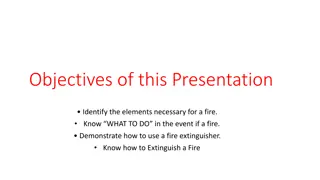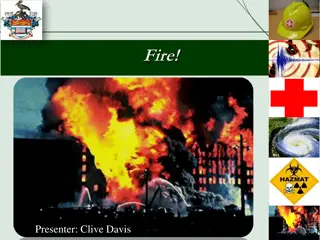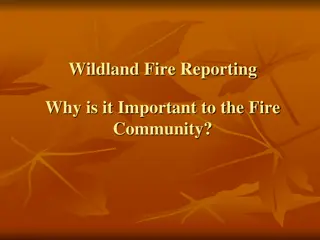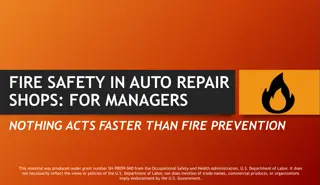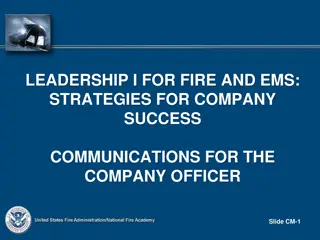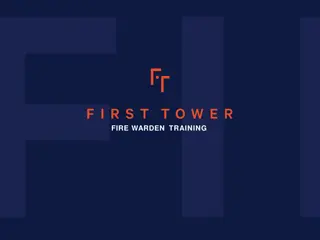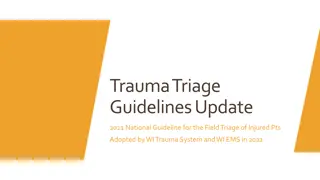Strategies for Managing Multiple Roles in Fire and EMS Leadership
Explore the essential strategies for personal success as a Company Officer in the fire and EMS field, focusing on identifying, prioritizing, and balancing multiple roles. Learn how to conduct a role-set analysis, handle role conflicts, and serve as a role model for subordinates. Enhance your leadership skills and accountability to excel in your position.
Download Presentation

Please find below an Image/Link to download the presentation.
The content on the website is provided AS IS for your information and personal use only. It may not be sold, licensed, or shared on other websites without obtaining consent from the author. Download presentation by click this link. If you encounter any issues during the download, it is possible that the publisher has removed the file from their server.
E N D
Presentation Transcript
LEADERSHIP II FOR FIRE AND EMS: STRATEGIES FOR PERSONAL SUCCESS MANAGING MULTIPLE ROLES FOR THE COMPANY OFFICER Slide MR-1
OBJECTIVES The students will: Prepare a personal role-set analysis. Identify four levels of accountability. Identify possible sources of role conflict for the Company Officer (CO). Develop and apply a balancing strategy for resolving role conflicts. Recognize the importance of the CO serving as a role model for subordinates. Slide MR-2
OVERVIEW Identifying and Prioritizing Multiple Roles Role Expectations Role Conflicts The Company Officer as a Role Model Accountability The Leadership Role Slide MR-3
IDENTIFYING AND PRIORITIZING MULTIPLE ROLES Definition: A set of expected behaviors that characterize your part in a particular situation. A function or office assumed by an individual. Multiple roles: We play many different roles daily. Not unusual. Slide MR-4
IDENTIFYING AND PRIORITIZING MULTIPLE ROLES (cont'd) Roles can be either formal or informal Formal: Inside the organization--station commander, lieutenant, paramedic Outside the organization--parent, child, president of the PTA Informal: Inside the organization--mentor, informal leader, "Godfather" Outside the organization--friend, neighbor, community activist Slide MR-5
IDENTIFYING AND PRIORITIZING MULTIPLE ROLES (cont'd) Role-set analysis is the process in which an individual attempts to: Identify all his/her roles (role set) Prioritize multiple roles Define role expectations Identify existing or potential role conflicts Develop balancing strategies to eliminate or reduce role conflicts Slide MR-6
IDENTIFYING AND PRIORITIZING MULTIPLE ROLES (cont'd) Benefits of role-set analysis Clarify own personal values Understand others Improves time management Enhances your ability to be equitable and fair Improves quality of your performance Slide MR-7
Activity MR.1 Personal Role-Set Analysis Identifying and Prioritizing Roles Slide MR-8
Writer Fire Science Board Member Son or Daughter Parent Spouse Golfer Fire Chief Church Member ME Subordinate of City Manager Student Homeowner Civic Board Member Instructor Consultant Slide MR-9
ROLE EXPECTATIONS Definition: How you are expected to act within a specific role What's expected of you when you assume that role Sources: Key senders Self expectations Slide MR-10
ROLE EXPECTATIONS Role ambiguity Unsure of what's expected of you Key sender sends conflicting messages Role ambiguity causes: Stress, confusion, feelings of inadequacy, lack of direction If unsure, seek clarification and open lines of communication Slide MR-11
Activity MR.2 Personal Role-Set Analysis Role Expectations Slide MR-12
ROLE CONFLICTS Intrarole conflict Conflict within a specific role Two types: Your expectations versus key senders Key sender versus key sender Slide MR-13
ROLE CONFLICTS (cont'd) Interrole conflict Conflict between two or more separate roles Two types: When an individual is expected to perform two or more different roles simultaneously When role priorities are out of balance Slide MR-14
ROLE CONFLICTS (cont'd) Interpersonal role conflict A conflict between two or more individuals playing parallel roles Examples: Two parents disagreeing about how children should be disciplined; two COs disagreeing about apparatus maintenance Slide MR-15
ROLE CONFLICTS (cont'd) What are some other examples of interpersonal role conflicts? Slide MR-16
ROLE CONFLICTS (cont'd) Balancing role conflicts Inevitable. Recognize serious conflicts. Develop balancing strategies. Most critical strategy is clearly delineating your priorities. Slide MR-17
ROLE CONFLICTS (cont'd) Intrarole priorities: If there's a conflict between your expectations and a key sender's expectations, which has priority? If there's a conflict between key senders, who is most important? Interrole priorities: Which role is more important? The closer any role is to the "me" on the role-set analysis, the more important the role. Slide MR-18
ROLE CONFLICTS (cont'd) Interpersonal priorities How important is the conflict issue? Learn to accept and live with minor differences. Resolve any critical differences? Slide MR-19
ROLE CONFLICTS (cont'd) Common characteristics of people who handle role conflict well: Preference for taking initiative Confidence and persuasiveness Social poise, spontaneity, and talkativeness Preference for flexibility Strong desire to affiliate with people Moderate desires for achievement and power Slide MR-20
ROLE CONFLICTS (cont'd) Ability to reach own conclusions Rewards come from success High priorities to planning and goal- setting Lack of excessive feelings of pressure In agreement with policies of department Slide MR-21
ROLE CONFLICTS (cont'd) What are some examples of people you know who seem to be especially good at handling role conflict? Slide MR-22
Activity MR.3 Personal Role-Set Analysis Role Conflicts Slide MR-23
THE COMPANY OFFICER AS A ROLE MODEL Responsibility to do best possible job with resources available. Remember, your subordinates are watching you! Your status as a CO means you are now a part of management and must support management positions. This means becoming an effective role model-- a person subordinates and peers can look up and emulate. Slide MR-24
THE COMPANY OFFICER AS A ROLE MODEL (cont'd) Becoming an effective role model means being professional. Composite of personal skills and attitudes: -- Attitude. -- Behavior. -- Communication. -- Demeanor. -- Ethics. Slide MR-25
THE COMPANY OFFICER AS A ROLE MODEL (cont'd) Attitude: State of mind. "Your attitude is showing!" Reflected in appearance, attire, and adornments. A positive attitude is contagious! Slide MR-26
THE COMPANY OFFICER AS A ROLE MODEL (cont'd) Behavior: Behavior is how you act. Influences your subordinates. Professional COs will: Exercise self discipline. Control emotions. Exercise moderation and discretion off duty as well as on duty. Slide MR-27
THE COMPANY OFFICER AS A ROLE MODEL (cont'd) Communication: How we get our message across "People" business Communication skills include: Oral communication Written communication Nonverbal communication Slide MR-28
THE COMPANY OFFICER AS A ROLE MODEL (cont'd) Appearance Behavior Communication Demeanor: Sum total of A, B, and C. Manageable. Conscious awareness of problems in the area of appearance, behavior, and communication skills will enable us to work on eliminating these problems. Slide MR-29
THE COMPANY OFFICER AS A ROLE MODEL (cont'd) Ethics involve conforming to the standards of conduct for a given profession. Lack of ethics can destroy respect for a supervisor. Slide MR-30
THE COMPANY OFFICER AS A ROLE MODEL (cont'd) Other qualities of the supervisor as role model: Enthusiasm Initiative Self-discipline Courage Integrity Loyalty Good judgment and decisiveness Empathy Discretion Desire for self-improvement Slide MR-31
THE COMPANY OFFICER AS A ROLE MODEL (cont'd) Summary: Professionalism in the form of "ABCDE" approach will help to ensure status as a professional. The CO should always remember: "Your employees are watching you!" Slide MR-32
Activity MR.4 Role Model Profile Slide MR-33
ACCOUNTABILITY Four areas of accountability: Accountability to self Accountability to company Accountability to organization Accountability to public Slide MR-34
ACCOUNTABILITY (cont'd) Accountability to self. We are all accountable to ourselves first. We must be able to live with our decisions. -- "What do you think of the person you see in the mirror?" -- We are often harder on ourselves than others are. Slide MR-35
ACCOUNTABILITY (cont'd) Accountability to the company Unique personalities and standards "Norm" differs from company to company Look out for personnel Slide MR-36
ACCOUNTABILITY (cont'd) Accountability to the organization. Formal (and informal) representative of management. Blaming your "upper management" for your problems will generally come back to haunt you! Your actions and professionalism as a CO can help to motivate others and ultimately, the organization itself. Slide MR-37
ACCOUNTABILITY (cont'd) Accountability to the public. Protect and serve the public. Department mission must be carried out. The more efficient and effective we are as the COs, the better the service we can provide. The better our company can work together as a team, the better the job it will do on the fireground. Slide MR-38
THE LEADERSHIP ROLE Leadership role functions Things the organization expects you to do Critical behaviors Ten critical role functions fall into three categories: Interpersonal functions Informational functions Decisional functions Slide MR-39
THE LEADERSHIP ROLE (cont'd) Interpersonal functions Figurehead: the performance of ceremonial duties CO at the annual awards ceremony CO awarding prizes to elementary school children participating in a fire prevention poster contest Slide MR-40
What are some other examples? Slide MR-41
THE LEADERSHIP ROLE (cont'd) Leader: taking the direct actions typical of a leader; directing, ordering, counseling, disciplining, etc. CO directing personnel on the emergency scene CO conducting a counseling session Slide MR-42
What are some other examples? Slide MR-43
THE LEADERSHIP ROLE (cont'd) Liaison: making contacts with others, both inside and outside the organization (serving as a link) CO as a link between upper-level managers and company members. Officer setting up a drill on natural gas hazards with a representative of the local gas company Slide MR-44
What are some other examples? Slide MR-45
THE LEADERSHIP ROLE (cont'd) Informational functions Monitor: scanning the environment for critical information; staying informed; keeping up with the times. CO "360s" the building during size up. Officer inspects site of a construction dig to ensure hole is properly shored. Keeping abreast with new technology Spotting trends. Slide MR-46
What are some other examples? Slide MR-47
THE LEADERSHIP ROLE (cont'd) Disseminator: giving out information others would not otherwise have CO holding a meeting with his/her personnel Officer acting as a coach with new recruit Slide MR-48
What are some other examples? Slide MR-49
THE LEADERSHIP ROLE (cont'd) Spokesperson: giving information to people outside of their unit or staff Officer addressing homeowner's association on the value of smoke detectors in the home CO serving as departmental Public Information Officer (PIO) CO notifying the chief of a critical company problem Slide MR-50
